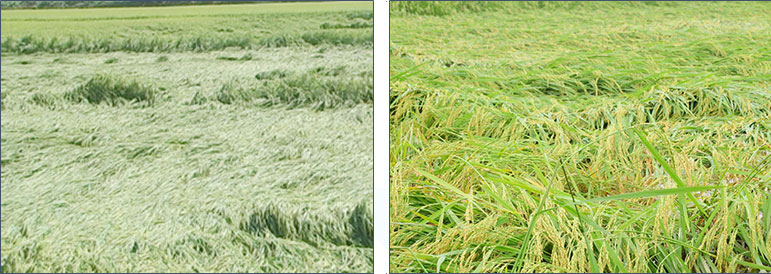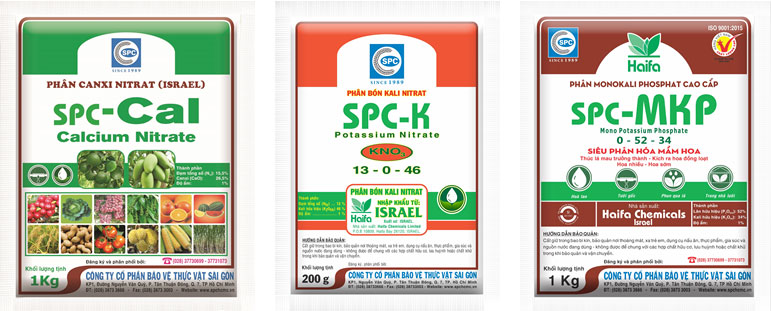|
Causes Of Rice Falling And Remedies
05/08/2021
BSc. Do Cong Hoang When rice falls, will cause a lot of damage to farmers, in addition to increasing costs due to more difficult harvesting, early falling rice also reduces yield, increases harvest loss rate and reduces quality of agricultural products due to wetness and mud adhesion. How to prevent and remedy this phenomenon? First of all, we need to find out what causes rice plant to fall. The phenomenon of rice fall has several causes, some of the main causes can be listed as follows: A/ Objective reasons: 1/ Due to adverse weather conditions: This cause is easy to see, especially in the Summer-Autumn or Autumn-Winter crop, the weather is often cloudy, rainy, and lacks light, so rice plants tend to grow in height. , when encountering heavy rain and high winds, sometimes even whirlwind, if the rice plant is in the milky stage onwards, it is easy to fall due to the imbalance of weight between the root and the top. 2/ Due to low-lying land: On the of low-lying fields, with continuous deep water flooding, the rice is usually tall, the body is soft, it is easy to fall, and it is easy to be attacked by pests such as: Brown plant hopper, leaf roller, sheath blight, blast diseases... B/ Subjective reasons: 1/ Due to unbalanced fertilization: This is very common in fields that are poor in phosphorus, potassium and calcium, or soil with high humus content If too much nitrogen fertilizer is applied, it is not balanced with phosphorus and especially potassium, which will lead to weak rice falling. We all know that nitrogen is an element that helps plants grow in height of leaves, making cells grow quickly, but the cell wall is weak because it has not yet accumulated cellulose, it is easy to fall when there are not enough elements to help plants firm and grow harmoniously and in balance with nitrogen, which is phosphorus, Potassium and Calcium. 2/ Due to rice varieties: For rice varieties that give weak plant, poor fertilizer tolerance that we do not have to adjust, still fertilizing normally like other rice varieties or sowing too thickly also makes rice prone to fall. 3/ Due to infection: Fields with excess nitrogen fertilizer, thick sowing, or continuously flooded, when exposed to wet weather (a lot of rain or fog) are easily attacked by fungal diseases such as: Rice blast, sheathblight, early ripening of yellow leaves, etc. dry the foot leaves, so the level of falling is more serious. C/ Remedy: Fellow farmers should apply the integrated measures 1/ Land preparation: - After harvesting, the fields need to be plowed and dried the soil to create a plowing base, the field will not be muddy, help mineralize organic substances and reduce toxins in the soil, help rice roots grow, absorb nutrients better, more hardy rice plant . - Rice fields need to be flat and have a drainage system slightly inclined towards the drainage water so that when needed, the drainage is easy, the water management when spraying herbicides and fertilizing is also more convenient. 2/ Seeds and sowing density: Should choose hardy rice varieties, both resistant to pests and diseases, and limit falling when the rice is ripe. For example, some are like: OM 11735, OM 18, OM 426, OM 429, OM 8901, OM 7262, Huong Chau 6 (applicable to western provinces), HG12, VNR20, VNR88, Kim Cuong 111 (Central provinces, Central Highlands)… - Farmers need to apply a sparsely reasonable method of sowing, if sowing in rows, the amount of seed is from 80-100kg/ha, widespread sowing with the amount of seed from 100-120kg/ha. Sparse sowing saves seed, also helps rice roots to develop well, strong body, hard plant, less pests, less falling, easy to harvest by machine. 3/ Fertilizer and water management: This is an important measure - To avoid excessive nitrogen fertilization, farmers should apply fertilizer according to the rice leaf color chart. Fertilization in earing period; if the rice is too green, apply potassium fertilizer and spray more foliar fertilizer SPC MKP (0 – 52 – 34) or SPC-K (13 – 0 – 46). In addition to adequate and balanced fertilization between Nitrogen, Phosphorus and Potassium, right from the beginning of the crop, it is necessary to add calcium to the rice by using a fertilizer with the commercial name SPC-CAL, the chemical name is Calcium Nitrate (which farmers are used to calling calcium nitrate or milk urea) with the following dosages: + Period 10 - 15 days after sowing: Apply 20 - 25 kg of SPC-Cal /ha + Period 40 - 45 days after sowing: Apply 25 - 30 kg of SPC-Cal /ha - Fertilizing SPC-Cal combined with foliar spraying of SPC-MKP, SPC-K also helps to reduce alum, organic detoxification of the soil help rice plants develop root system and absorb nutrients better. At the same time, calcium is also an essential semi-macro nutrient for plants, helping the cell walls to connect firmly, enhance resistance to pests and diseases, increase resistance to adverse weather and prevent from falling when flooded. - It is recommended to drain the water out for about 7 days before the rice plant in earing to help the rice roots penetrate deeply, create aeration in the field, enhance photosynthesis to accumulate organic matter to help the rice firm. 7-10 days before harvesting, it is necessary to drain the water so that the rice will be firm, less prone to falling, and easy to harvest. 4/ Spraying for disease prevention and treatment: In the case of thick sowing, excessive nitrogen fertilization or planting of specialty varieties but weak plants that are susceptible to diseases, wet weather, etc. to limit falls and yield losses, it is necessary to increase Spraying with insecticides against sheatblight and blast: - Sheath blight disease: Spraying with products such as: Saizole 5SC or Vanicide 5SL in the 30 days and 45 days after sowing . - Blast disease: + The rice in tillering-and earing period , if blast spots appear on the leaves, it is necessary to pay attention to early spraying with products such as: Trizole 75WDG, 75WP, Lua Vang 20WP or Saipan 2L. + In the period before opening of rice ear 5-7 days and after opening of rice ear about 80-90% of the ear of rice , even if rice appears disease or not also need to conduct preventive spraying with the above-mentioned products. |
To prevent, in addition to plowing and burying weed seeds, collecting weed stalks and stumps left after tilling the land to burn, not letting weeds produce seeds in production fields, etc., the use of chemical products is still a measure. optimal because of its ability to thoroughly kill weeds, reduce labor and take advantage of more time than manual weeding.
Miner has the scientific name Phyllocnistis citrella Staint., family Phyllocnistidae, order Lepidoptera. The miner occurs in many countries in the tropics and subtropics. The main host of the miner is the citrus family - Rutaceae. In addition, the miner also attacks mangosteen and some other plants.
Adult is a small planthopper, with a body 2-3 mm long, the whole body is ash gray, slightly greenish, the wings are opaque with many small brown spots.Eggs are oval, 0.3 mm long, have a pointed end and are attached directly to the leaf surface, leaf axils.
Green bugs specialize in the fruit of citrus groups (oranges, tangerines, lemons, grapefruits, kumquats...), some people call them orange bugs, or orange suckers. Their scientific name is Rhynchocoris poseidon or Rhynchocoris humeralis.
In Vietnam, yellow leaf curl disease is very common on papaya trees, especially the disease is often severe in areas of high and continuous planting, areas with hot and arid climates. The disease has significantly reduced the yield and quality of papaya. Gardens that are infected early when the plants are young may not yield. However, up to now, many gardeners still do not know the cause and how to fix it.
Spider mites are common pests on citrus trees, especially in hot and dry climates that are suitable for spiders to grow and cause severe damage.The group of harmful spiders is usually very small in size, unlike the natural enemy spiders.
This group includes species that are generally very small in size, causing damage by sucking plant sap (on leaves, fruits, branches, stems).
There are many species of mealybugs present on the group of Oranges,Tangerines,Grapefruits and Lemons (Citrus), which can be divided into 2 groups:
+ Group of sticky mealybugs with common varieties such as Lepidosaphes, Aonidiella, Coccus and Saissetia.
+ Group of flower mealybugs with common genera and species such as Pseudococcus, Planococcus and Icerya purchasi.
Dry branches and berries disease often appear to be common damage on coffee gardens during the rainy season. The disease causes death of branchs, dry fruit, severely affects the canopy structure and coffee yield if not paid attention to prevention.
Pink disease commonly causes diseases on rubber plantations in the rainy season, especially on garden from 4-8 years old. This year, rubber has to go through a period of severe drought, weakening the tree, so now in tnshe rainy season it is easy to get infected. Therefore, it is necessary to pay attention to good management to avoid affecting the garden.
In recent years, the area of citrus has been expanded because it is a fruit tree with high economic efficiency. However, in order to sell at a high price, not only in quality but consumers also require the external beauty of the fruit, so pest management on citrus is a matter of great concern to farmers. The hot season is a favorable condition for thrips to develop and cause damage, affecting the commercial value of fruit.
- Headquarters
- SAIGON PLANT PROTECTION JOINT STOCK COMPANY
- RQ 1, Nguyen Van Quy St., Tan Thuan Ward, HCM City
- Tax code: 0300632232
- Tel: (028) 38 733 295 - 38 732 077
- Fax: (028) 38 733 003 - 38 733 391
- Website: www.spchcmc.vn - Email: info@spchcmc.vn
- SAIGON PLANT PROTECTION COMPANY
- SAIGON PLANT PROTECTION JOINT STOCK ENTERPRISE
- Lot C1-C3 Hiep Phuoc Industrial Park, Hiep Phuoc Commune, HCM City
- Tel: (028) 3873 4089 - Fax: (028) 3873 4086
- Affiliated Unit
-
- Quick Links
- Home
- About us
- Career Opportunities













